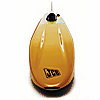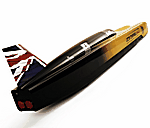JCB launches bid to break land speed record

JCB has launched an attempt to crack the world land speed record – with a diesel powered vehicle.
A significant shift from the British manufacturer’s usual output of agricultural, construction and groundscare kit, this latest project is being viewed as an opportunity to boost the profile of the company’s home-grown engines which were launched two years ago.
 Using technology from its diggers, loaders and high-speed tractors, the Staffs-based company has enlisted the help of racing specialists Ricardo and Visioneering to modify its engines and develop a record-breaking car.
Using technology from its diggers, loaders and high-speed tractors, the Staffs-based company has enlisted the help of racing specialists Ricardo and Visioneering to modify its engines and develop a record-breaking car.
The 9m long DieselMax streamliner will be driven by the current fastest man on earth – Wing Commander Andy Green – who took the jet-powered Thrust SSC through the sound-barrier to 763mph in 1997.
When he heads out to the Bonneville Salt Flats in Utah, USA in August this year with the car and engineering team he is likely to reach a more sedate 300mph – beating the current diesel-driven record of 236mph which was set in 1973.
The car is powered by two of the engines developed by JCB for its backhoe diggers and telescopic loaders.
Mounted on their side at the front and rear of the car, each of the four-cylinder JCB 444-LSR powerplants is bored out from 4.5 to 5-litres and gains huge twin turbochargers which pump air into the engine at a pressure of 5bar (74psi).
Fuel is delivered by an electronically controlled common-rail setup through high volume solenoid actuated injectors.
Two six-speed racing-spec transmission units – front and rear – couple the engines to their respective final drives. These are mated to each powerplant by a version of the oil-immersed multi-plate clutch used in JCB’s 3CX diggers.
Unusually for a racing car the engine rotates slower than the wheels and so a ‘step-up’ gear is required within this transfer box arrangement.
With aerodynamics as a key factor in the car’s design, there is no opportunity for radiators as these would create too much drag. Consequently cooling for both blocks and the four turbos is provided by a 200-litre tank of ice in the vehicle’s nose. This stays below boiling point just long enough for the car to make its first nine-mile dash.
To achieve a record-breaking run the DieselMax must be turned round, its ice and fuel tanks refilled and brake parachutes repacked before making the return trip within an hour.
The record attempt will take place on the week following the infamous Bonneville Speed Week in August.
* The DieselMax’s engines are the first JCB powerplants to be fitted with common-rail injection systems. Later this year the company will introduce this technology to its telehandler and backhoe digger engines. As well as ensuring they meet Tier III emissions legislation, this will allow the company to squeeze up to 160hp out of its 4.5-litre, 4-cylinder block.
| JCB DieselMax Tech Spec | |
|---|---|
Engines | 2 x JCB 5-litre common-rail diesels. |
Cooling | 200-litre ice tank |
Power | 750bhp @ 3800rpm |
Torque | 1500Nm @ 2500rpm |
Transmission | 6-speed barrel-shift with JCB 3CX |
Driveline | Forward engine connected to front wheels; |
Brakes | Carbon hub rotors and twin stators; |
Weight | 2.7 tonnes |
Speed | 300mph |

